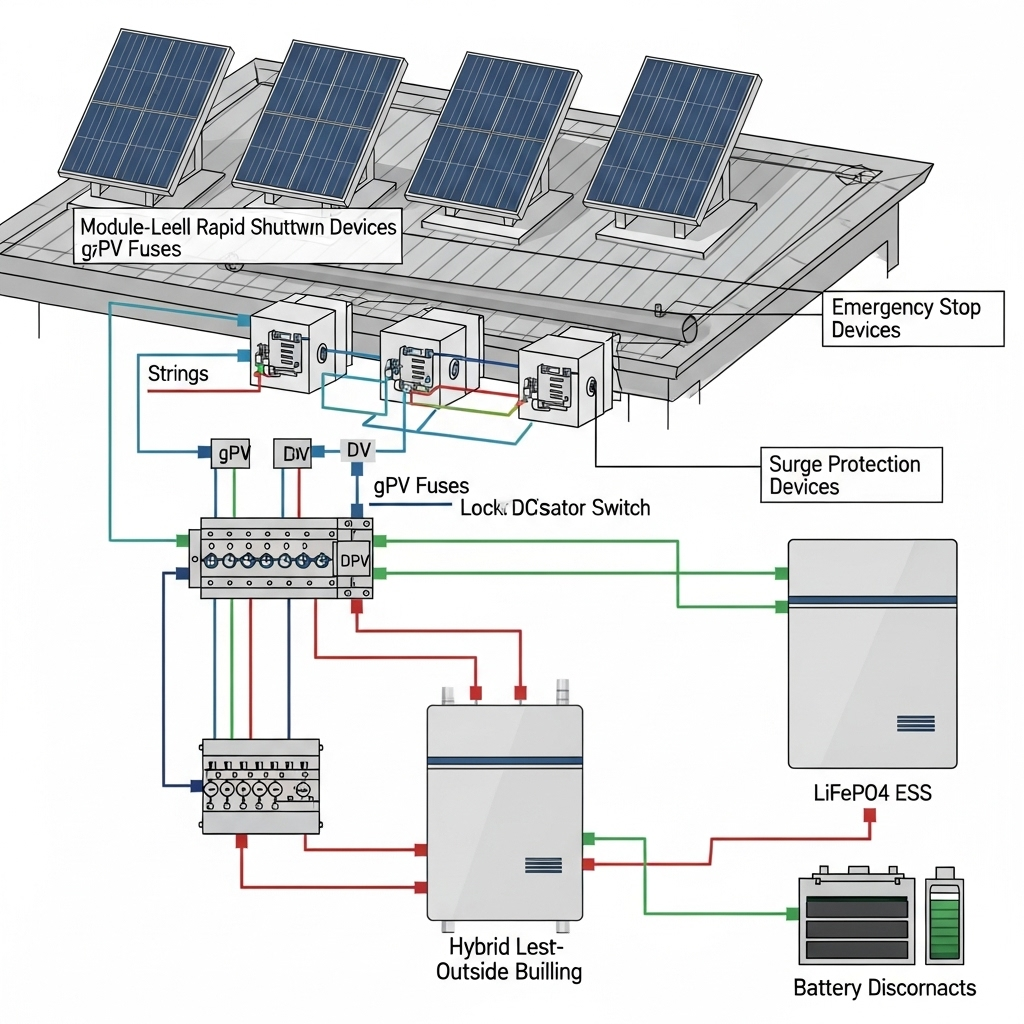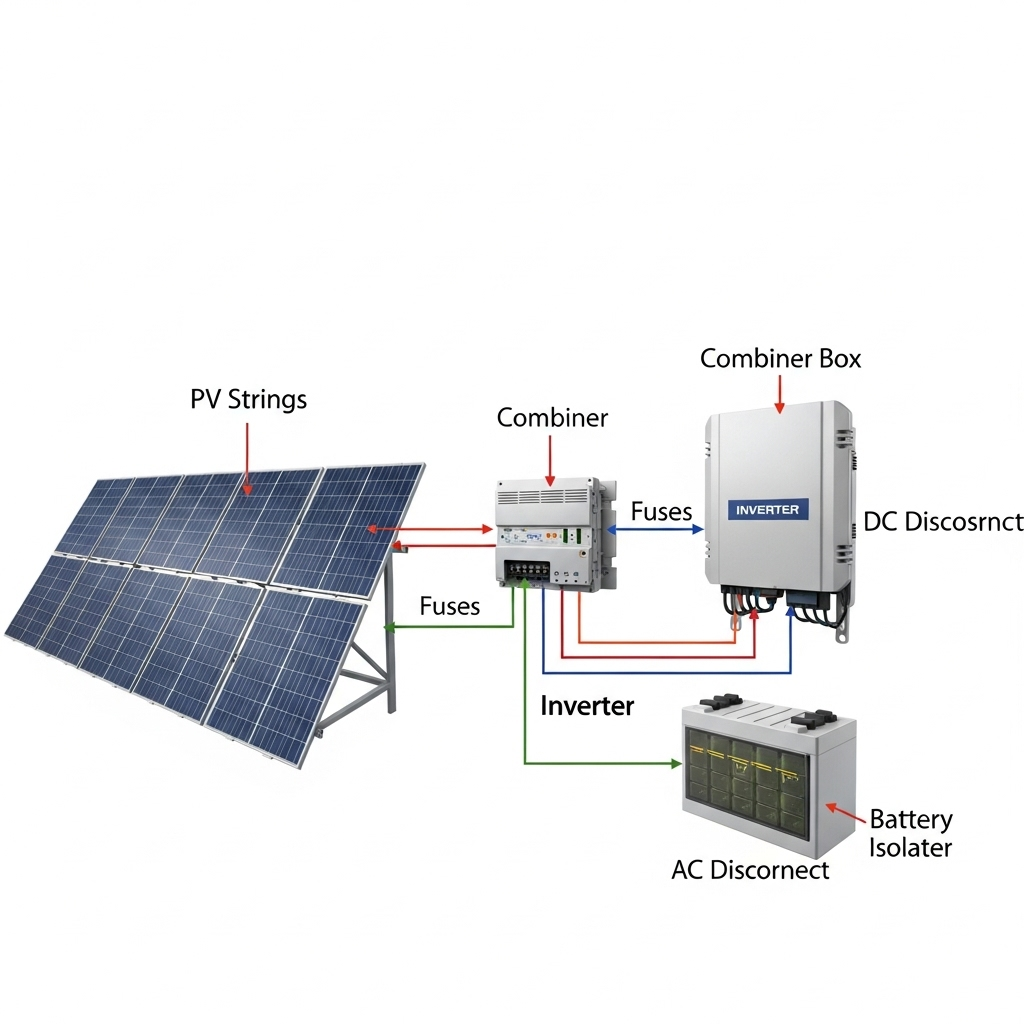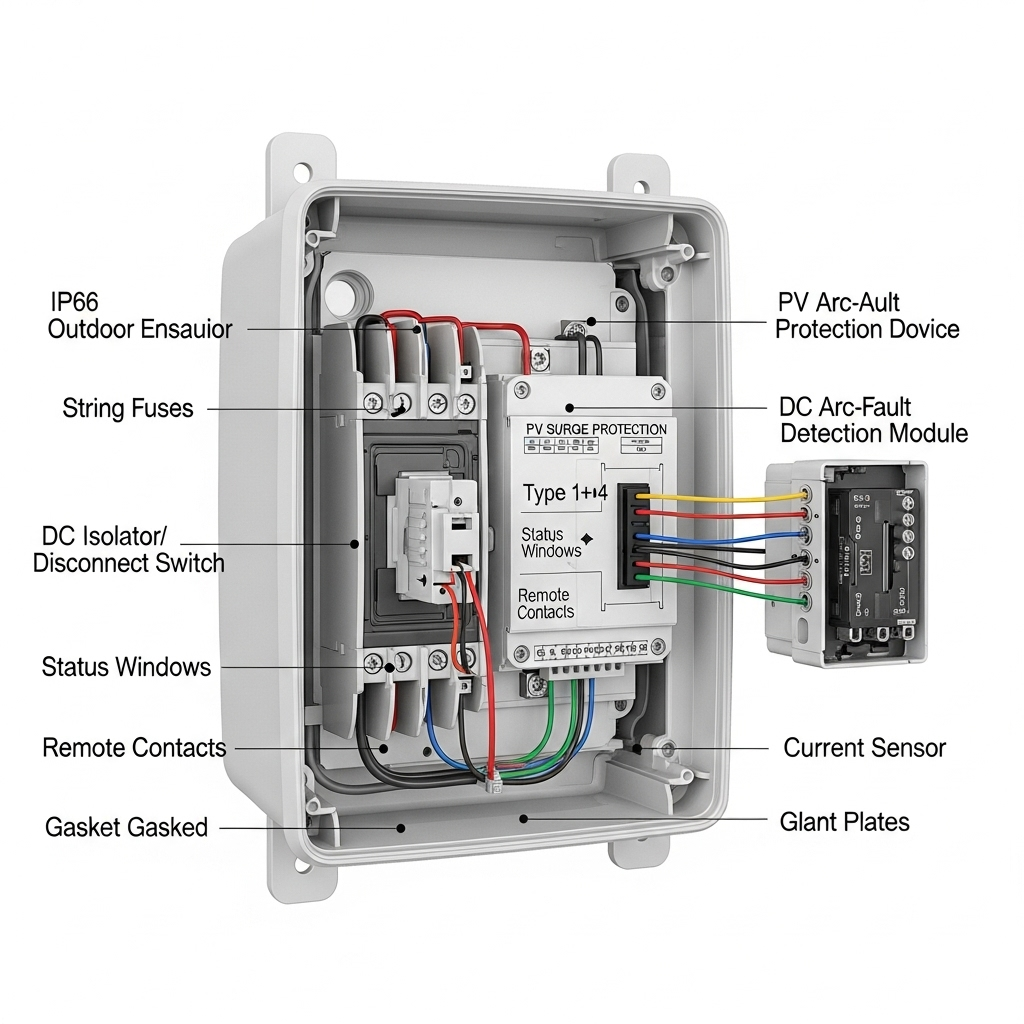Rapid shutdown saves lives during emergencies, and combiner isolation protects gear and crews. This blueprint shows how to tie both into a clean, code-compliant PV and storage design. It focuses on practical device choices, isolator switch operation, and the test evidence authorities expect.
Why rapid shutdown and combiner isolation matter together
Rapid shutdown basics
In many jurisdictions, rapid shutdown requires PV conductors inside the array boundary to drop to a safe voltage in a set time window. A common threshold is 80 V within 30 seconds. The intent is simple: firefighters and technicians need low touch voltage fast. Achieving this usually takes module-level rapid shutdown devices (RSD), microinverters, or a listed hazard control system.
Combiner box functionality
A PV combiner box concentrates multiple strings. Typical functions include:
- Overcurrent protection with gPV fuses per IEC 60269-6
- Surge protection devices (Type 1 or 2 per IEC 61643-31)
- String-level monitoring or home-run metering
- A lockable DC isolator switch per IEC 60947-3 for safe maintenance
Combiner isolation and rapid shutdown serve different moments of risk. Rapid shutdown protects first responders during an event. The isolator switch supports day-to-day servicing and fault containment.
Policy and code context you can build on
High-performing designs align technical measures with clear verification. According to IRENA’s Grid Codes for Renewable Powered Systems, the strongest compliance results come from combining type tests, on-site commissioning, simulation, and in-operation monitoring. This blend raises confidence and reduces approval friction. The U.S. Department of Energy groups rapid shutdown within broader PV safety practices. The IEA report on Rooftop Solar PV in India highlights that clear building-code rules, rooftop ownership policies, and distributed resource coordination improve safety and investment outcomes.
Device choices and proven architectures
Three reliable patterns
Pick a pattern that satisfies local rules and your site’s risks.
| Pattern | Typical parts | What it solves | Constraints | Common code path |
|---|---|---|---|---|
| Module-level RSD on each module | String inverter, RSD per module, combiner with fuses, DC isolator | Fast voltage drop at module level; fits complex roofs | More parts on roof; plan wiring and labeling | Meets rapid shutdown time/voltage limits; isolator per IEC 60947-3 |
| Microinverters | AC trunk, no DC combiner, roof AC disconnect as needed | Module-level shutdown inherent; simple DC risk profile | Trunk layout planning; AC aggregation gear | Rapid shutdown via de-energized AC trunk; local AC isolation rules |
| UL 3741 hazard control system | Tested racking + inverter pair, may reduce module devices | System-level compliance verified by listing | Stay within listed combinations; documentation is key | Rapid shutdown via listed PV Hazard Control System |
Add a combiner with isolation if you aggregate DC strings. For hybrid inverters and storage, keep PV rapid shutdown on the array side. Treat battery isolation as a separate path.
Isolation hardware: ratings, operation, and a sizing example
Picking the right isolator switch
Use DC-rated isolators per IEC 60947-3 (e.g., utilization categories DC-PV2/DC-PV1). Check:
- Voltage rating at the site’s temperature-corrected open-circuit voltage (Voc)
- Current rating at or above maximum continuous current with a safety factor
- Polarity and pole configuration (ungrounded arrays usually need 2-pole isolation)
- Make/break duty under load and arc suppression at the system’s DC voltage
For fuses, select gPV class with current rating above 1.25 × string short-circuit current (Isc), and coordinate with the inverter’s max input current. Surge protection should match the system’s maximum DC voltage and expected surge environment.
Worked sizing example
Assume 10 strings in parallel. Each string: 11 modules, Voc at STC = 48 V, Isc = 10 A.
- Array Voc at STC: 11 × 48 = 528 V
- Temperature-corrected Voc: use module data; a 1.2 multiplier is a common cold-day estimate → 528 × 1.2 ≈ 634 V
- String OCPD sizing: Isc × 1.25 × 1.25 = 10 × 1.56 = 15.6 A → use 20 A gPV fuses
- Combiner bus current: 10 × 10 A = 100 A (use inverter max input if lower)
- Isolator current rating: ≥ 1.25 × 100 A = 125 A → select next standard size, e.g., 160 A at ≥ 600–700 V DC with DC-PV2 rating
Validate these numbers against module, fuse, and switch datasheets. Confirm local rules for safety factors and labeling. For U.S. sites, align with NEC 690.8 current calculations and 690.12 rapid shutdown. For other regions, follow national PV installation standards and emergency switching rules.
Compliance blueprint: from design to sign-off
What authorities and insurers expect
Strong files reduce back-and-forth. Build a packet that includes:
- Single-line diagram highlighting rapid shutdown boundaries, device locations, and combiner isolation
- Device listings for RSD, inverters, isolators, fuses, SPDs
- Voltage and current calculations, temperature corrections, and arc-fault notes
- Label schedule and placards for emergency services
Verification plan that actually works
IRENA recommends blending type tests, on-site tests, simulation, and operational monitoring to lift confidence and control cost. Adopt that approach:
- Type tests: use listed devices with clear ratings and certificates
- Commissioning: verify rapid shutdown time with a stopwatch and meter, check isolator make/break under load conditions, validate fuse continuity and SPD status
- Simulation: model Voc at cold extremes and inverter MPPT windows; document margins
- Monitoring: log RSD trigger events and combiner currents for early fault detection
| Requirement | Device or method | Field check | Record to keep |
|---|---|---|---|
| Rapid shutdown voltage/time limit | RSDs or listed hazard control system | Trip RSD and measure voltage at array boundary | Timestamped readings, photo of meter |
| Safe isolation for maintenance | Lockable DC isolator at combiner | Open under stated load; inspect contacts per schedule | Isolator datasheet and maintenance log |
| Overcurrent protection | gPV fuses per string | Continuity test; spare inventory noted | Fuse curves and coordination notes |
| Surge protection | Type 1/2 SPD | Indicator check; clamp test if applicable | SPD spec, replacement plan |
Certification and clear roles raise trust. As IRENA notes, involving certification bodies and combining test strategies improves the ratio of compliance achieved to cost.
Storage integration: keep PV shutdown and battery isolation distinct
LiFePO4 ESS realities that shape the design
Modern residential ESS often pair a hybrid inverter with a LiFePO4 battery. Round-trip efficiency for LiFePO4 typically sits in the 92–96% band, and cycle life often exceeds 4,000 cycles at moderate depth of discharge. The Ultimate Reference: Solar & Storage Performance summary points to these ranges and explains how temperature and C-rate affect lifetime. High efficiency cuts heat, which helps enclosure design and SPD selection.
Rapid shutdown operates on the PV side. Battery isolation is separate. Include:
- Battery DC disconnect (manual) plus contactor controlled by the BMS
- Pre-charge path for inrush into inverter DC link
- Clear labels distinguishing PV rapid shutdown from battery emergency stop
Hybrid and off-grid cases
For islanded or backup modes, ensure the RSD path still receives its control signal or power. Many RSDs latch open. Others need a keep-alive or release line from the inverter or a dedicated controller. Document how shutdown works during grid outages and generator use.
Realistic risk controls and O&M
Arc-fault and insulation checks
Rapid shutdown does not replace DC arc-fault detection or insulation monitoring. Keep these features active in the inverter. Log events and correct array wiring or connectors that trigger nuisance trips.
Data that supports better operations
Growth brings scrutiny. EIA tracks rapid gains in PV deployment, which increases the need for consistent safety practices. Use string-level data to spot underperforming circuits early. Replace degraded SPDs and suspect fuses proactively.
Wrapping up the blueprint
Pair module-level rapid shutdown or a listed hazard control system with a properly rated combiner isolator. Size fuses and switches with temperature and current margins. Prove compliance with a blended test plan and keep clean records. This approach shortens approvals, reduces service risk, and protects crews.
Disclaimer: This material is technical information, not legal or code advice. Always confirm requirements with your Authority Having Jurisdiction and a licensed professional.
FAQ
Do I still need a rooftop DC isolator if the system has rapid shutdown?
That depends on local rules and the inverter or hazard control listing. Many sites accept module-level shutdown plus an accessible DC isolator at the combiner or inverter. Confirm with your AHJ. Non-legal advice.
Does combiner isolation replace arc-fault protection?
No. The isolator is for safe maintenance and fault containment. Keep DC arc-fault detection enabled in the inverter, and address root causes if it trips.
How do I field-test rapid shutdown time?
Open the emergency stop or RSD control. Measure conductor voltage at the array boundary with a meter. Confirm it falls below the required threshold within the specified seconds. Record readings with timestamps and photos.
Can a contactor serve as the array isolator?
Only if it is DC-rated for the voltage, current, and duty. Many designs use a manual lockable switch for clarity and reliability. If using a contactor, include a manual means of isolation and fail-safe logic.
What documentation speeds approvals?
Provide a single-line diagram, device listings, current/voltage calculations, rapid shutdown test evidence, and a label schedule. Reference IRENA’s guidance on coordinated verification to show your test plan is complete.





Leave a comment
All comments are moderated before being published.
This site is protected by hCaptcha and the hCaptcha Privacy Policy and Terms of Service apply.